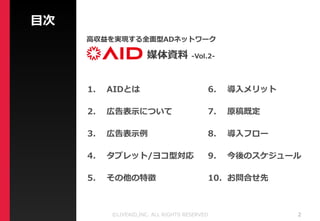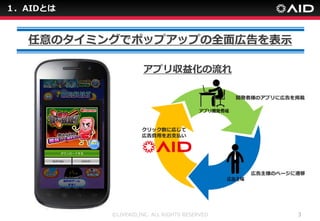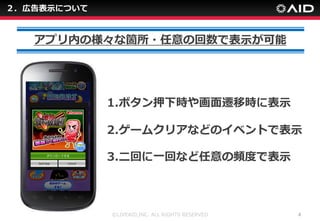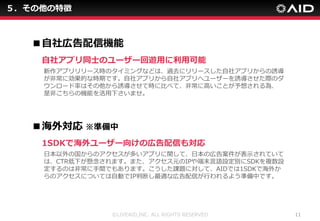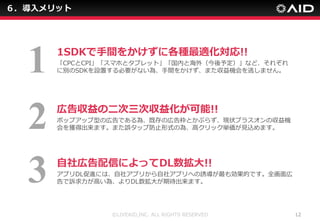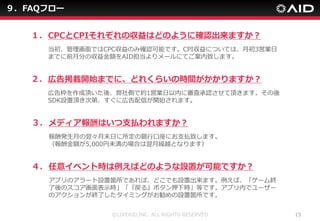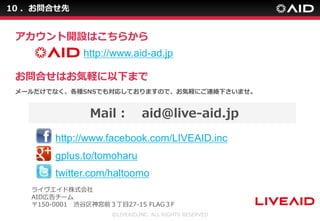【メディア様用】Aid媒体資料 ver2.1
- 2. 目次 高収益を実現する全面型ADネットワーク 1. AIDとは 2. 広告表示について 3. 広告表示例 4. タブレット/ヨコ型対応 5. その他の特徴 6. 導入メリット 7. 原稿既定 8. 導入フロー 9. 今後のスケジュール 10. お問合せ先 媒体資料 -Vol.2- ?LIVEAID,INC. ALL RIGHTS RESERVED 2
- 3. 1.AIDとは 任意のタイミングでポップアップの全面広告を表示 3?LIVEAID,INC. ALL RIGHTS RESERVED 開発者様のアプリに広告を掲載 広告主様のページに遷移 クリック数に応じて 広告費用をお支払い アプリ収益化の流れ
- 4. 4 2.広告表示について ?LIVEAID,INC. ALL RIGHTS RESERVED 1.ボタン押下時や画面遷移時に表示 アプリ内の様々な箇所?任意の回数で表示が可能 3.二回に一回など任意の頻度で表示 2.ゲームクリアなどのイベントで表示
- 5. 5 3.広告表示例(ゲームスコア画面) ゲームを一区切りしたユーザー様に広告を訴求するため、 広告効果が最も高く収益(単価)が上がり易い ?LIVEAID,INC. ALL RIGHTS RESERVED 任意イベントの アクション (例:ゲームスコア画面表示) ポップアップにて 全面広告表示 広告へ遷移で収益発生※1 ※1 一部アプリDLで収益が発生する広告も御座います。
- 6. 6 3.広告表示例(アプリ起動時) ?LIVEAID,INC. ALL RIGHTS RESERVED ※広告の読み込みが発生するため、アプリ 起動時のスプラッシュ画面が必要です。 アプリ起動時に表示、全てのユーザーが広告に接触するため 表示回数が多く、一定のクリック数を確保
- 7. 3.広告表示例(アプリ終了時) 7?LIVEAID,INC. ALL RIGHTS RESERVED バックキーで アプリ終了アクション ポップアップにて 全面広告表示 アプリ終了時に広告を表示、アプリから離れるタイミングで表 示可能なためクリック数と単価のバランスが良い
- 8. 3.広告表示例(特定ボタン押下時) 8?LIVEAID,INC. ALL RIGHTS RESERVED 任意のボタン押下 画面遷移後 ポップアップ 様々な箇所へ広告を表示させることができるため 広告の導入が容易
- 9. 9 4.タブレット/ヨコ型対応 1SDKでタブレット/ヨコ型サイズの広告配信にも対応 タブレットやゲームアプリに多い横スクロール型のコンテンツにも対応してい るため、収益機会を逃しません。 ?LIVEAID,INC. ALL RIGHTS RESERVED ヨコ型掲載例 タブレット掲載例
- 10. 10 5.その他特徴(誤タップ防止) 1タップの質を高めることでCPC単価を高く維持 業界的に問題である「誤タップ」を防止している為、良質なタップを広告主へ提供することが可能。それ により、広告主の継続出稿を促し、またCPC単価を高めに維持することが出来ます。 ?LIVEAID,INC. ALL RIGHTS RESERVED 広告画像をタップ 遷移可能な「緑色」ボタンが 上部にスライドし 「閉じる」ボタンが出現 ■広告主様メリット ?質の高いタップの獲得 ■メディア様メリット ?CPC収益性向上?維持 「誤タップ防止」 ※ボタン内の表示文字は広告主にて自由設定
- 11. 11 5.その他の特徴 ■自社広告配信機能 自社アプリ同士のユーザー回遊用に利用可能 新作アプリリリース時のタイミングなどは、過去にリリースした自社アプリからの誘導 が非常に効果的な時期です。自社アプリから自社アプリへユーザーを誘導させた際のダ ウンロード率はその他から誘導させて時に比べて、非常に高いことが予想される為、 是非こちらの機能を活用下さいませ。 ?LIVEAID,INC. ALL RIGHTS RESERVED ■海外対応 ※準備中 1SDKで海外ユーザー向けの広告配信も対応 日本以外の国からのアクセスが多いアプリに関して、日本の広告案件が表示されていて は、CTR低下が懸念されます。また、アクセス元のIPや端末言語設定別にSDKを複数設 定するのは非常に手間でもあります。こうした課題に対して、AIDでは1SDKで海外か らのアクセスについては自動でIP判断し最適な広告配信が行われるよう準備中です。
- 12. 12 6.導入メリット 1SDKで手間をかけずに各種最適化対応!! 「CPCとCPI」「スマホとタブレット」「国内と海外(今後予定)」など、それぞれ に別のSDKを設置する必要がない為、手間をかけず、また収益機会を逃しません。 ?LIVEAID,INC. ALL RIGHTS RESERVED 1 2 3 広告収益の二次三次収益化が可能!! ポップアップ型の広告である為、既存の広告枠とかぶらず、現状プラスオンの収益機 会を獲得出来ます。また誤タップ防止形式の為、高クリック単価が見込めます。 自社広告配信によってDL数拡大!! アプリDL促進には、自社アプリから自社アプリへの誘導が最も効果的です。全画面広 告で訴求力が高い為、よりDL数拡大が期待出来ます。
- 13. 13 7.原稿既定(自社広告設定時) 原稿サイズと容量に特に注意 原稿既定外の広告は配信エラーとなってしまう為、設定時にはご注意をお願いします。 ?LIVEAID,INC. ALL RIGHTS RESERVED 掲載面 原稿サイズ 容量 ファイル形式 アニメーション リンク先URL 遷移ボタン文言 アプリ終了時/任意イベント時 左右300 × 天地250ピクセル 100KB以内 JPG/PNG/GIF 可 原稿毎に設定可能 全角15文字以内(半角可能) AD
- 14. 14 8.導入フロー 最短約1営業日で広告配信開始まで手配可能 SDKは非常にシンプルでWebでアカウント申込を頂いた後、最短約1営業日で広告配信開始が可能です。 ?LIVEAID,INC. ALL RIGHTS RESERVED Webでアカウント申込 広告枠登録 SDK実装 広告配信開始 アカウント開設用URL http://aid-ad.jp お申込み後、約1営業日以内に管理画面を発行。 広告枠登録後、弊社にて審査承認させて頂きます。 その後すぐにSDK実装 ? 広告配信が可能です。 Androidアプリの許可(パーミッション)について AIDで使用する許可は「インターネット通信」のみ となります。また、UDIDなどの個体識別番号は取 得しておりません。 配信開始後のレポート数値は、約1時間毎に更新 され、管理画面に反映されます。
- 15. 9.FAQフロー 15 1. ?LIVEAID,INC. ALL RIGHTS RESERVED CPCとCPIそれぞれの収益はどのように確認出来ますか? 当初、管理画面ではCPC収益のみ確認可能です。CPI収益については、月初3営業日 までに前月分の収益金額をAID担当よりメールにてご案内致します。 2. 広告掲載開始までに、どれくらいの時間がかかりますか? 広告枠を作成頂いた後、弊社側で約1営業日以内に審査承認させて頂きます。その後 SDK設置頂き次第、すぐに広告配信が開始されます。 3. メディア報酬はいつ支払われますか? 報酬発生月の翌々月末日に所定の銀行口座にお支払致します。 (報酬金額が5,000円未満の場合は翌月繰越となります) 4. 任意イベント時は例えばどのような設置が可能ですか? アプリのアラート設置箇所であれば、どこでも設置出来ます。例えば、「ゲーム終 了後のスコア画面表示時」「『戻る』ボタン押下時」等です。アプリ内でユーザー のアクションが終了したタイミングがお勧めの設置箇所です。
- 16. 10 .お問合せ先 お問合せはお気軽に以下まで メールだけでなく、各種SNSでも対応しておりますので、お気軽にご連絡下さいませ。 ?LIVEAID,INC. ALL RIGHTS RESERVED gplus.to/tomoharu http://www.facebook.com/LIVEAID.inc twitter.com/haltoomo Mail : aid@live-aid.jp ライヴエイド株式会社 AID広告チーム 〒150-0001 渋谷区神宮前3丁目27-15 FLAG3F http://www.aid-ad.jp アカウント開設はこちらから


